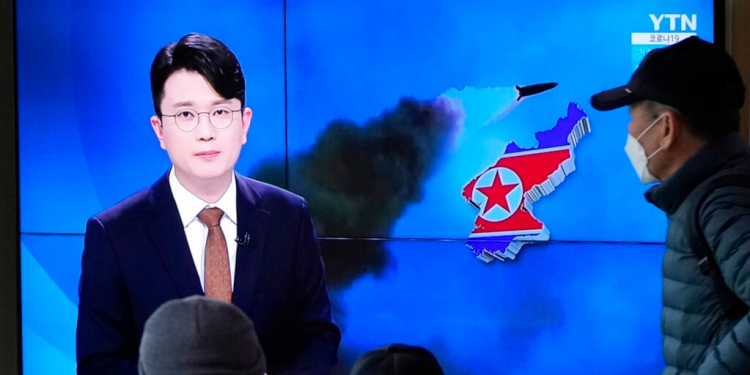North Korea conducted “another important test” of a reconnaissance satellite system, state-run media said Sunday, a day after Japan, South Korea and the U.S. reported an apparent ballistic missile launch by the country — the second such launch in a week.
The nuclear-armed country’s National Aerospace Development Administration and its Academy of Defense Science “conducted another important test on Saturday under the plan of developing a reconnaissance satellite,” the official Korean Central News Agency reported.
“Through the test, the NADA confirmed the reliability of (the) data transmission and reception system of the satellite, its control command system and various ground-based control systems,” KCNA said.
The test was the country’s ninth missile launch of 2022 as it continues an unprecedented pace of weapons tests. It also came just days ahead of South Korea’s March 9 presidential election and as much of the world is focused on the war in Ukraine.
North Korea was hit with international condemnation when it last launched a satellite into orbit in February 2016. Outside experts have questioned whether the North’s satellites have been working properly, with some calling the rocket launches thinly veiled attempts to master longer-range missile technology.
Rockets used to put satellites into orbit employ much of the same technology as those types of ballistic missiles, technology Pyongyang is banned from using under United Nations Security Council resolutions.
Japanese Defense Minister Nobuo Kishi condemned the launch, saying Saturday that the missile had traveled about 300 kilometers, hitting a maximum altitude of 550 km and landing in waters outside Japan’s exclusive economic zone, which extends 200 nautical miles (370 km) from its coast.
“This launch comes at a time when the international community is dealing with Russia’s invasion of Ukraine, and also when the Beijing Paralympics are being held. It is unacceptable,” Kishi said.
“The significant pace that North Korea is developing its missile technology is not something our country and the surrounding regions can overlook,” he added, saying that Tokyo had protested the move through diplomatic channels.
Saturday’s launch came after the North said it had conducted “an important test” on Feb. 27 for developing a military reconnaissance satellite. That test was also conducted from the same area in Pyongyang as Saturday’s test and traveled about 300 km, hitting a maximum altitude of 600 km.
At a rare ruling party congress in January last year, North Korean leader Kim Jong Un announced a number of goals for further improving his impoverished country’s military as part of a five-year plan. The unusually detailed list of weapons capabilities included the development of military reconnaissance satellites “in the near future.”
Japan’s Defense Ministry said Sunday that it believed the launch a day earlier was another test of the military satellite system Kim mentioned in his January 2021 address.
Prior to the satellite test, the North tested a Hwasong-12 intermediate-range ballistic missile on Jan. 30. Tokyo said the weapon has a range of 5,000 km — putting all of Japan and the U.S. territory of Guam within striking distance. It was the first such test since November 2017. Both Japan and Guam are home to key U.S. military bases that would be used in any crisis on the Korean Peninsula.
North Korea has hinted at ending its self-imposed moratorium on nuclear and long-range missile tests while calling on Washington to drop what it said is a “hostile policy” toward Pyongyang.
Those remarks and the spate of recent launches have stoked concern that Kim may be opening the door to tests of increasingly powerful weapons after years of focusing on less provocative launches.
Saturday’s test also came as the world remained fixated on Russia’s invasion of Ukraine.
Senior U.S. officials have attempted to tamp down concerns that the Ukraine crisis could take Washington’s focus off the North Korean nuclear threat, with Secretary of State Antony Blinken saying that the United States can “walk and chew gum at the same time” even as it faces down other global challenges.
Experts say the pace of tests is likely to continue according to Kim’s schedule, regardless of the world’s focus on the conflict in Ukraine.
Following the conclusion of a lengthy review of the United States’ North Korea policy last year, President Joe Biden has repeatedly said that his administration harbors no “hostile intent” toward Pyongyang and is prepared to meet “unconditionally” with a goal of “the complete denuclearization of the Korean Peninsula.”
But Kim has appeared uninterested in Biden’s pitch, condemning the U.S. offers as a “petty trick.”
Observers say the North Korean strongman has no intention of relinquishing his nuclear arsenal, as he believes it is key to his regime’s survival. Instead, he has ordered his regime to double down and prepare for a “long-term confrontation” with the United States.
In the near-term, Kim will have plenty of options to test his weapons, with a number of key anniversaries fast approaching.
The North has already begun preparations for an apparent military parade ahead of the important dates, according to the South Korean military, including the 110th birthday of Kim’s grandfather and the country’s founder, Kim Il Sung, on April 15.
The regime has been known to stage shows of force on or around dates marking every fifth or 10th anniversary, and military parades have often been employed to unveil powerful new weapons.































Discussion about this post